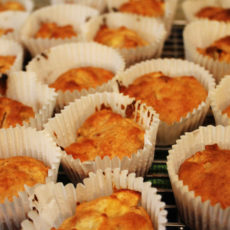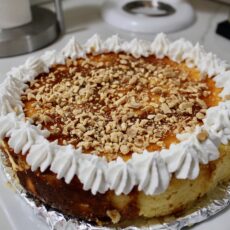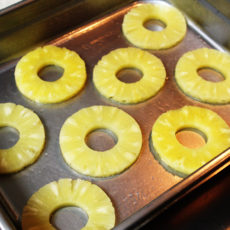As part of my Mother’s Day brunch this year (MD2017), I wanted to push my limits by attempting some of the hardest pastry recipes in the book. I tested my skills not only with 17-44: Homemade Danish Pastries, but with this recipe as well, 17-23: Mocha Éclairs. My mom always referred to éclairs as something that challenged her when she was learning to cook and bake, and that a well-executed one was something that really impressed her. With that in mind, I knew this recipe was a must-do.

I may have to make a few adjustments to Simply Delicious‘ version of the recipe–first of all, there’s no chocolate listed anywhere in this recipe, and it’s advertised as “mocha”, which is coffee AND chocolate. We may have to do something about this “slicing the tops off” idea as well.

What makes this recipe (and others like it) difficult is mainly timing–a lot of the components require constant attention and need to be pulled off the stove at the right time. Without prior experience, it can be difficult to simply read the instructions and know exactly what they mean, especially when they can only give you a few pictures, a brief description, and nothing else.
I’ve never made éclairs before, but I think I’ve done enough pastries and other types of complicated desserts at this point to at least have a decent shot at making them successfully.

Ingredients. I realize it seems counter-intuitive to use both lactose-free milk and heavy whipping cream, but I plan to make a few adjustments that will allow me to have just a few éclairs that are “lactose-modified”. I’ve got some disposable pastry bags in the back–I finally switched to those after having an untimely failure with an old washable/reusable one.

Melting down the butter in a saucepan.

Adding in the water, then turning up the heat to bring it to a boil.

As soon as you add the flour and salt, it quickly starts to thicken.

Here’s what they mean by a ball stuck to the side–it all clumps together like a dough ball.

Spreadable, yet sticks together.

I load the dough into a disposable pastry bag, and cut the tip off. Where I cut the tip determines how big these éclairs will be–I’d like these to be small (makes more pieces), so I’ll cut it relatively close to the end. If I wanted them larger, I’d cut it farther up from the end. Best part of the disposable bags–if it’s the wrong size, just transfer the dough into a new one and try again.

My ends could use a little work, but once they bake it’ll be hard to tell. This same type of dough (choux) makes lots of different desserts–like profiteroles, one of the desserts we served at the restaurant at which I worked previously. Instead of greasing or using wax paper, I’ll use the trusty Silpat.

After baking. They’re super light and airy–so far, so good.

Cooling on the rack. They deflated a little, but not much. Plus, now they look more authentic.

I decided to make pastry cream for the filling, which is essentially what they’re having you make here, but in a slightly different fashion than what I’ve done in the past. I like the CIA’s recipe (Culinary Institute, not the spy guys), but it’s all essentially different versions of custard, which is just fancy pudding if we want to get SUPER simple about it.

I’ve made pastry cream before–most notably a maple-bacon version for a dessert tart during my restaurant days and a Kahlúa version for a birthday-cake version of 16-37: Double Decadent Brownie Torte. This time, I’ll make it a brewed coffee version to keep it as similar to this recipe as possible.

Stirring the cornstarch into the milk for the pastry cream.

Broke the last yolk as I was cracking it. Oh well. I basically used their measurements but the CIA pastry cream recipe method to make my cream for these éclairs.

Ice baths are important for cooling the pastry cream down quickly. I was shown the above method, lining a larger bowl with ice and setting the smaller bowl in it.

Tempering the egg mixture before adding it back in–an important step I think Simply Delicious neglects to add which is why I like the CIA method better.

Whisking the cream–just when it feels like it’ll never come together…

…all of a sudden it just does. Quick–get it out of the pan now before you have sweet scrambled eggs on your hands.

When I was shown how to make the pastry cream ice bath, I was also shown this method (which the CIA method also shows) to cool the cream quickly and evenly–press it up along the sides of the bowl to thin it out. This also makes it cool down faster because it has more surface area exposed. Pressing the plastic wrap down onto the cream keeps moisture from forming on the wrap and dripping back into the cream, thinning it out and possibly causing separation.

I used an apple corer to pop out the middles of my éclairs which worked really well–not one of them broke down on me. For the ones too small for the corer, I used a vegetable peeler (which is a method that also works well on jalapeños). I just couldn’t slice them–I know some styles of éclairs are sliced, but I wanted the classic cream-filled kind that have it all enclosed inside the pastry shell.

Whipped my heavy cream to stiff peaks to fold into the coffee-spiked pastry cream.

I used another disposable pastry bag to fill each of the éclairs with the cream (except for two, which I filled with pastry cream that didn’t have cream mixed into it. That combined with the pastry shells, the glaze you see above (which is just coffee and powdered sugar), and the dark chocolate glaze I’m going to add in the next picture (also just coffee and melted dark baking chocolate) makes a “lactose-modified”-type of éclair that I sprinkled some brown sugar on to differentiate.
This mocha glaze seems kind of weak, and it’s not mocha if there’s not chocolate…

I melted down some dark baking chocolate I had bought for 17-44: Homemade Danish Pastries that I didn’t end up using and mixed it with some extra brewed coffee to cover each éclair with. Not the most perfect-looking, but definitely éclairs. Sprinkled the two “lactose-modified” ones with the brown sugar mix again to keep them marked.

Simple, but delicious. If I did it again I’d maybe make them look less “rustic”, but maybe that’s the beauty of them. My mom loved them, and was indeed quite impressed.
Grade: A-
Interested in the other dishes that I made for this year’s Mother’s Day brunch? (MD2017)
- 15-19: Layered Fruit Salad
- 17-44: Homemade Danish Pastries
- 17-23: Mocha Éclairs
- 5-4: Eggs Benedict
- 15-30: Champagne Sundaes



